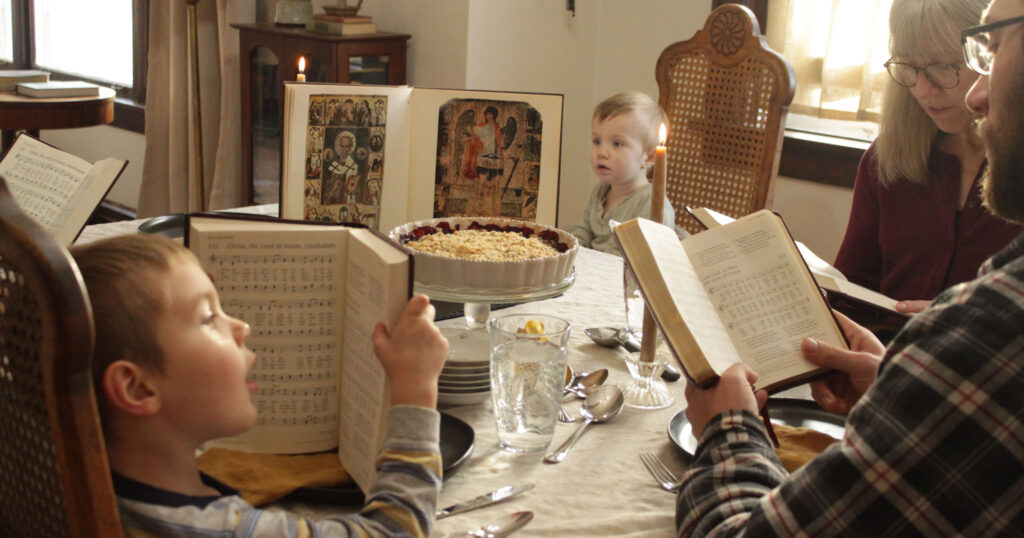This is the latest installment of “Life in the Church Year,” a series by Dr. Kristen Einertson and Tessa Muench of All the Household. This series will provide guidance for living out the seasons of the Church Year at home with your families. Find month-by-month lists of Lutheran feasts, festivals and commemorations here.
As the days shorten in the northern hemisphere and cooler weather arrives, November brings solemn occasions for Christians. Bookending the month, All Saints’ Day and the Last Sunday of the Church Year are bittersweet markers of both endings and beginnings.
All Saints’ Day, a commemoration for the faithful departed, recognizes the lives of all who have died in Christ. Originally focused on martyrs alone, the day has grown in scope for Lutherans, often now honoring all believers — great and small, known and unknown, past and present. It is an especially fitting time to remember those who have died in the past year. A cherished tradition in many congregations is reading the names of the departed while tolling a bell for each. This act acknowledges the close of earthly life and the beginning of heavenly life, marking our hope of reuniting with them when Christ returns.
This theme of Christ’s coming also ties All Saints’ to the Last Sunday of the Church Year, which this year falls on Nov. 23, marking the close of the church’s annual cycle. The Gospel readings leading up to this day — the Parable of the Ten Virgins or the man without a wedding garment — call us to readiness. We await Christ’s return to judge the living and the dead, urged by the church to stay awake, trim our lamps and keep our baptismal garments pure.
As we look toward this final coming, we also prepare for Christ’s first coming in the flesh at Christmas. Advent links together the end and beginning of the church’s cycle: We remember His incarnation while anticipating His return. This is why on the Last Sunday of the Church Year we pray, “Stir up Your power, O Lord, and come!” From this prayer comes a centuries-old custom: “Stir-Up Sunday,” the day for mixing Christmas pudding so that it can mature until the Nativity.

The pudding itself is rich with symbolism. Traditionally made with 13 ingredients for Christ and the 12 apostles, it is stirred east to west, recalling the Magi’s journey. Waiting through Advent as the pudding develops its flavor mirrors our own waiting for Christ. In our simplified version below, you need not wait until Christmas to eat it — though letting the flavors rest for a day or two makes it all the more delicious. As we make and eat it, we can reflect upon our earthly life as a time of preparation and waiting until we share in the feast of the Lamb on the Last Day.
Stir-Up Sunday Pudding
Ingredients:
⅔ cup chopped almonds ½ cup heavy cream 2 Tbsp. unsweetened cocoa powder 2 Tbsp. powdered sugar ¼ tsp. vanilla extract Pinch of salt 4 egg yolks ⅓ cup strong brewed coffee, room temperature 2 Tbsp. light brown sugar ½ tsp. cinnamon ¼ tsp. nutmeg ¼ tsp. salt ½ cup semi-sweet chocolate chips
Instructions:
- Place almonds in the bottom of six small jars, cups or ramekins.
- In a mixer, whip cream, cocoa, powdered sugar, vanilla and a pinch of salt until stiff peaks form. Chill.
- In a double boiler over low heat, whisk yolks, coffee, brown sugar, cinnamon, nutmeg and ¼ tsp. salt until foamy and doubled in volume (3–5 minutes). Remove from heat and stir in chocolate chips until melted. Cool to room temperature, stirring occasionally.
- Fold whipped cream into the cooled chocolate mixture in batches. Spoon over almonds. Top with extra chocolate chips, sea salt and cinnamon if desired. Cover and chill until serving.
Cover image: Tessa Muench





